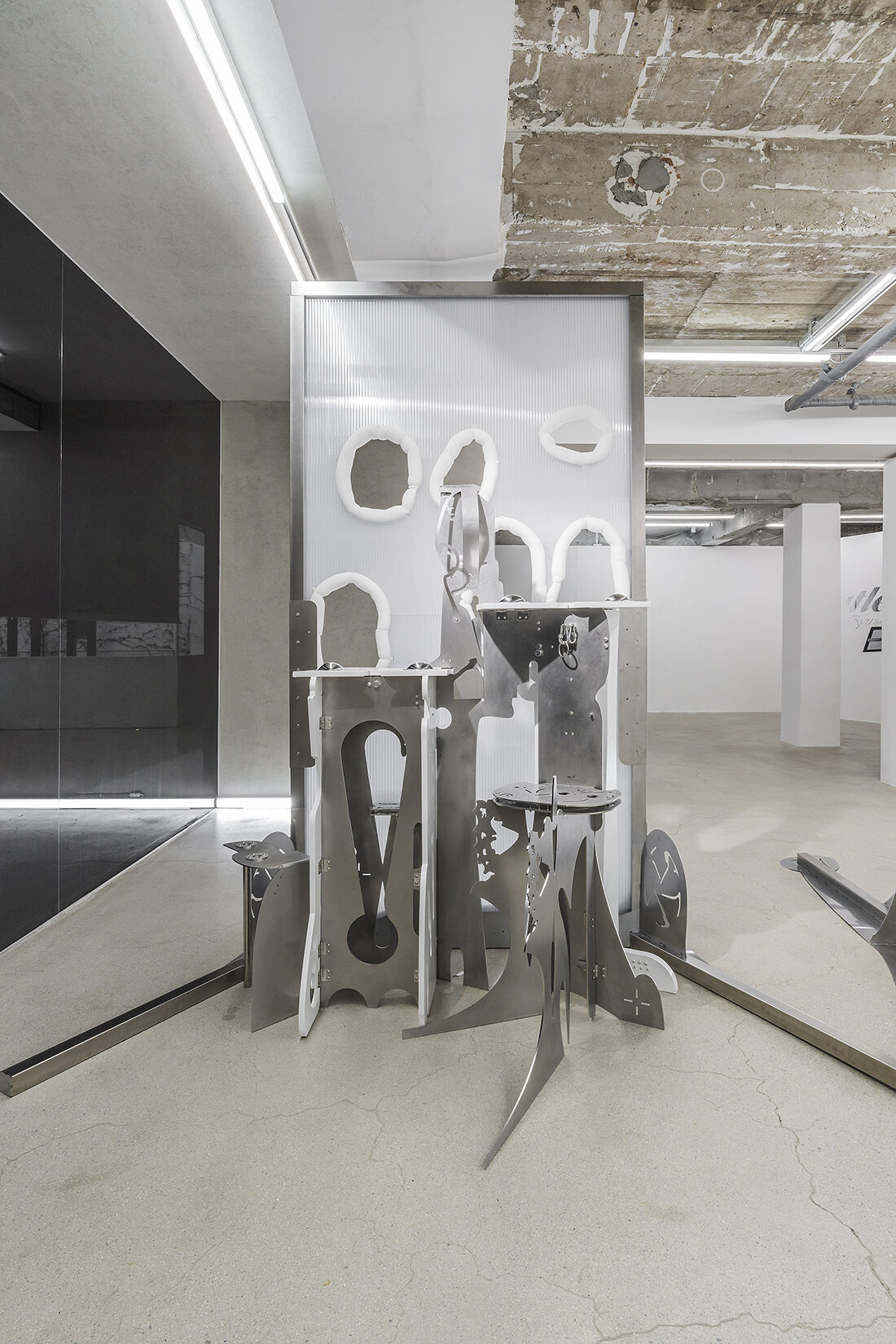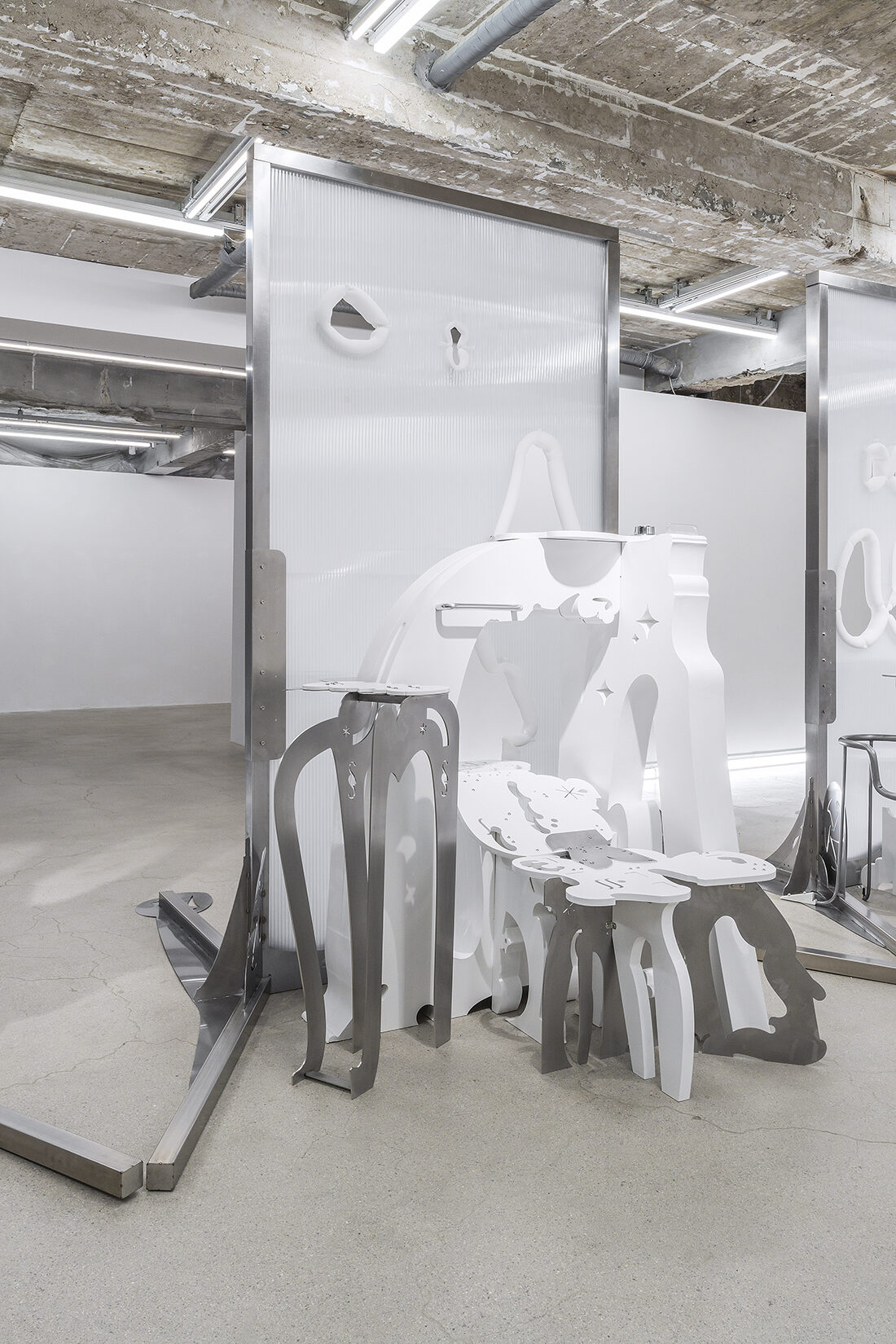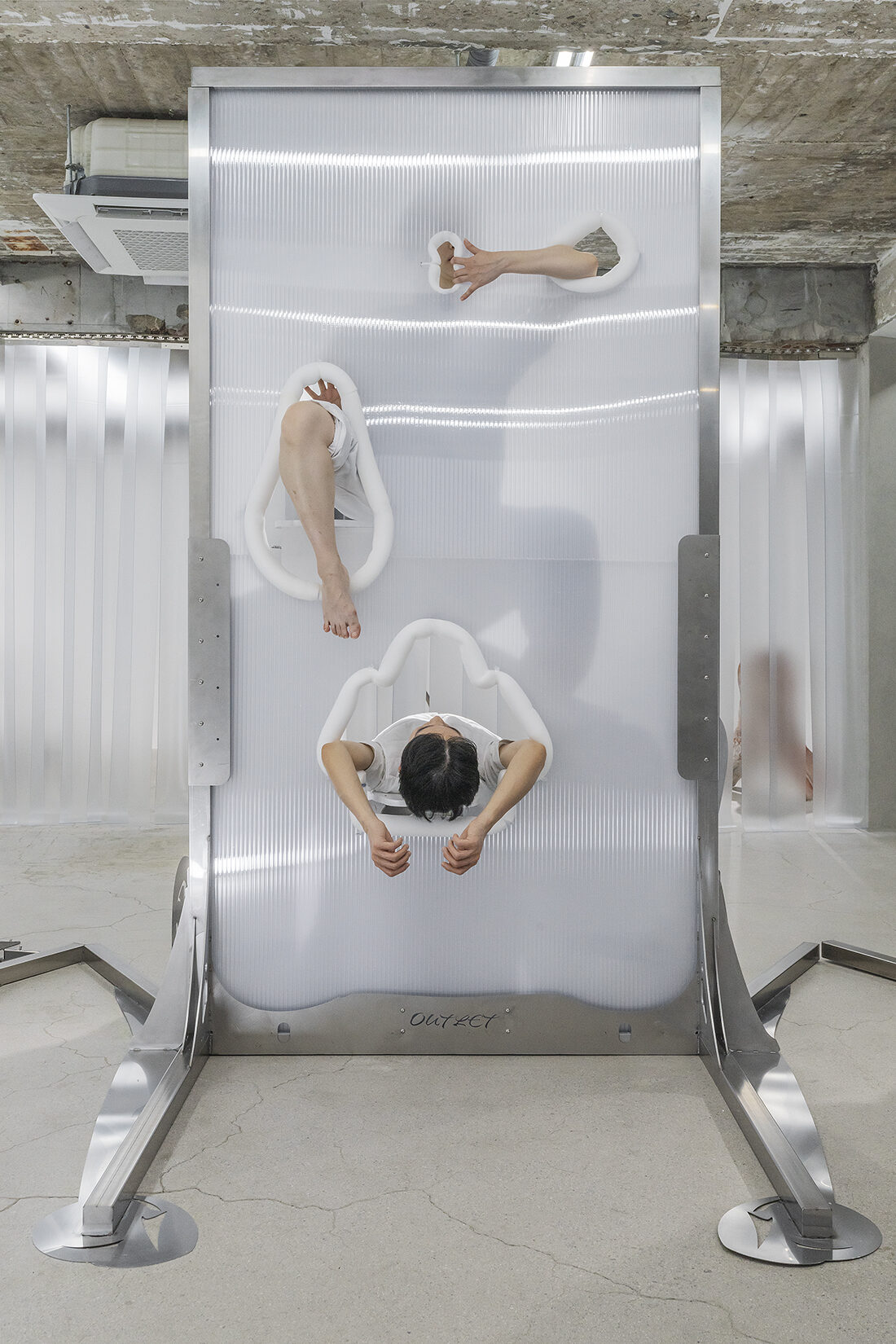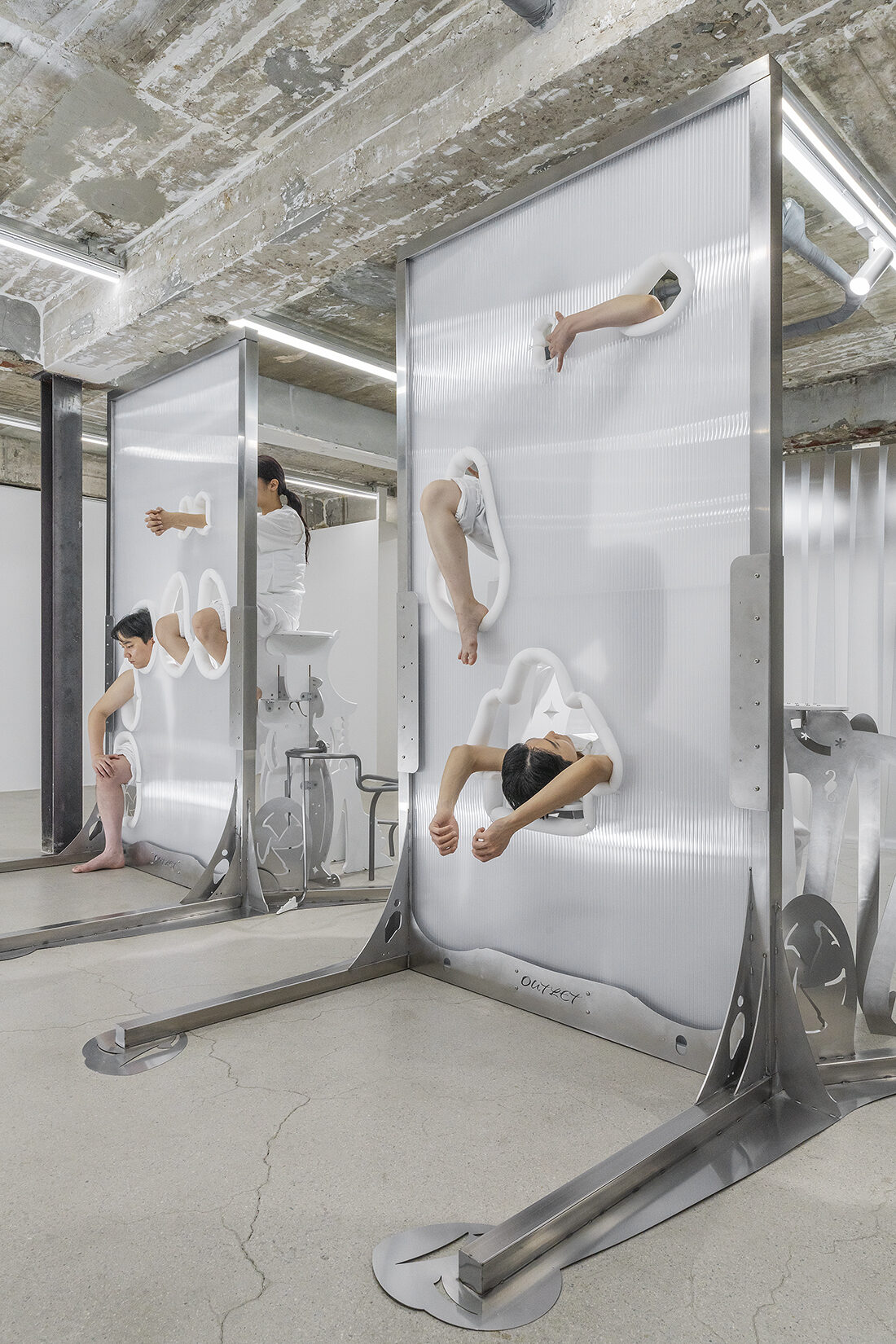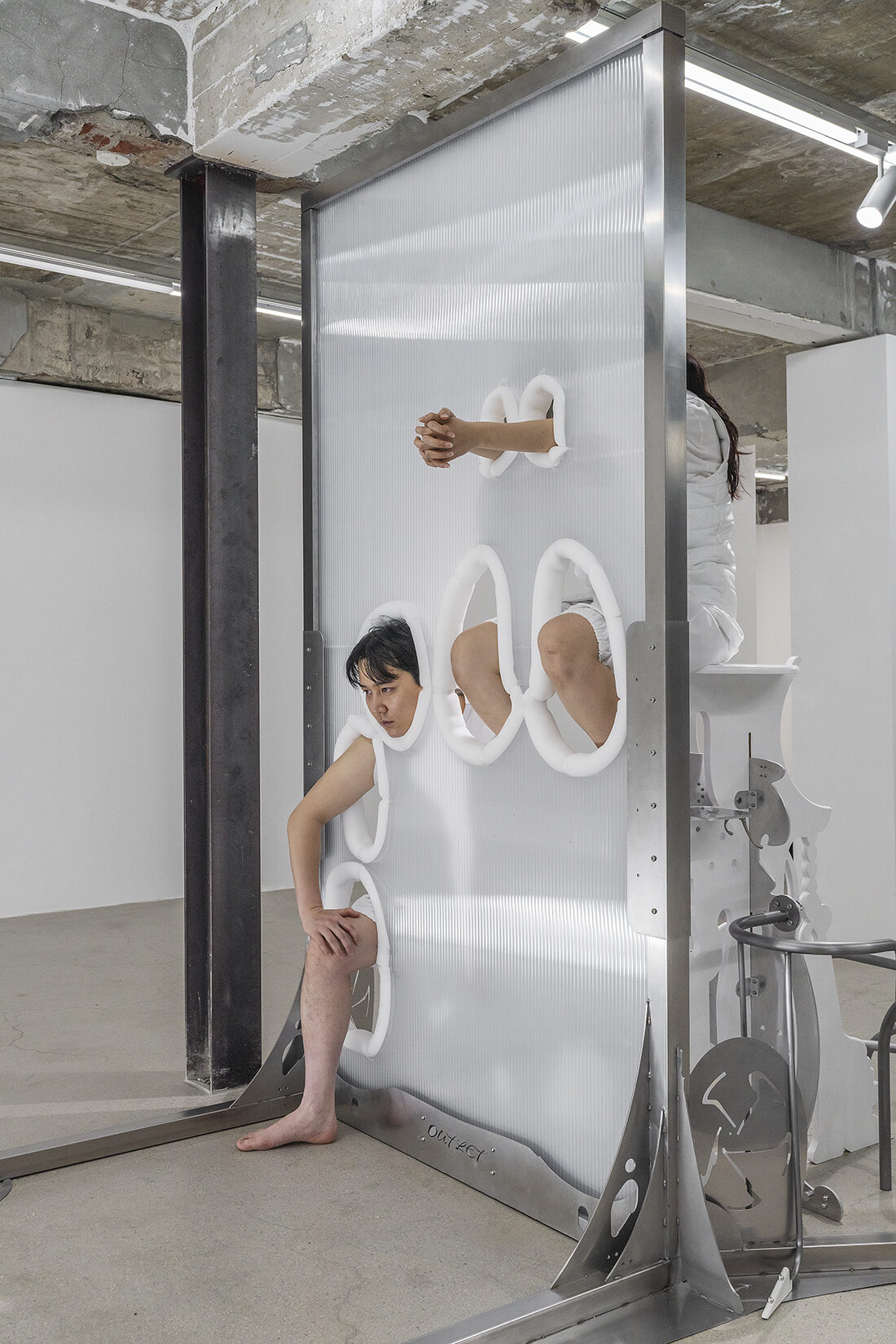《Outlet》
유아연 개인전
2023.12.15.-2024.01.27.
12:00-19:00 (일요일, 월요일 휴관)
서울시 종로구 계동길 84-3, 1층
퍼포먼스 l 매주 금요일 15:00-19:00
퍼포머 l 박준규 송정현 심유나 유보선 이소여 이수지 정성현
도움 l 김상소 이승준
그래픽 디자인 l 김신원
주최, 주관 l 뮤지엄헤드
후원 l 서울특별시, 서울문화재단
𝙊𝙪𝙩𝙡𝙚𝙩
Ahyeon Ryu
2023.12.15-2024.01.27.
12:00-19:00 (closed on Sunday, Monday)
Museumhead, 1F, 84-3, Gyedong-gil, Jongno-gu, Seoul
Performance | Every Friday, 15:00-19:00
Performer | Junkyu Park, Junghyeon Song, Yuna Shim, Boseon Yoo, Sawyer Lee, Suji Lee, Seonghyeon Jeong
Assistant | Sangso Kim, Seungjun Lee
Graphic Design | Shinwon Kim
Organized by Museumhead
Sponsored by Seoul, SFAC
전시 공간이 쇼핑몰을 닮아간다는 인상, 반대로 온갖 숍이 전시장을 닮아간다는 인상은 갈수록 지배적이다. 고도로 미학화 된 자본주의는 전시장과 다를 바 없는 상점을 내놓는다. 코스트코, 이케아 등의 초대형 매장들이 빨리 많이 팔기 위한 극도의 효율성을 기준으로 디자인되었다면, 이제 대세는 그 반대를 향한다. 팝업스토어 류의 새로운 상점은 전자가 취하는 체계와 질서, 상품 간의 계산된 인접성과 범주화 전략 대신, 다분히 비효율적이며 비생산적인 디자인을 택한다. 여백과 장식을 최대한 활용하여 심미적인 효과를 일으키고, 비좁더라도 이왕이면 독특한 정체성을 지닌 장소를 선호하며, 일시적인 경험을 상품과 더불어 판매한다.
유아연 개인전 《Outlet》은 심미적 경험의 판매대가 된 전시의 현실을 환기한다. 전시 제목인 ‘Outlet’은 특수 형태의 시장을 일컫는 말이다. 근과거의 아울렛이 못다 판 상품들을 헐값에 팔아 최소한의 잉여 수익을 확보하는 장치였다면, 이제 아울렛은 고가의 명품을 비교적 저렴하게 살 수 있는 소비의 방편으로 여겨진다. 소비의 성역은 없어지고 모든 것이 재-상품화된다. 작가는 전시 제목을 《Outlet》이라 정하며, 이러한 세태에서 자유롭지 않은 미술을 다시 한번 소비주의 논리 속에 던져 놓는다. 거의 항상 팔리지 않지만 상품을 자처해야 하며, 현재주의에 편승하면서도 끊임없이 철 지남(시대착오)의 시간성을 품는 미술 작품의 위상은 어딘지 모르게 아울렛 상품과 겹쳐진다.
전시장의 전체 구조 역시 상점을 흉내 낸다. 우선, 공간 외부 초입에 설치된 〈Outlet〉(2023)은 백색 조명으로 빛을 내는 조각으로, 전시 제목인 ‘Outlet’을 새겨 놓고는 간판의 뉘앙스를 풍기고 있다. 연 이은 기호를 따라 진입한 전시장 내부는 ‘쇼룸’과 ‘피팅룸’으로 구성된다. 각각은 특히 의류 매장에서 옷을 전시하는 공간과, 소비자가 구매에 앞서 그것을 입어볼 수 있는 공간을 구분하면서 사용하는 말이다. 쇼룸이 극적으로 몸의 가시성을 타자화하는 곳이라면, 피팅룸은 몸을 매개로 한 이미지의 은밀한 투사와 치열한 확인이 벌어지는 공간이다(매 계절, SPA 브랜드의 바겐세일 기간 피팅룸 앞의 인파를 떠올려 보라). 전시 《Outlet》은 이러한 장소성, 그리고 그에 연동하는 신체를 재현하고 비틀어 보인다.
관객은 전시장의 전면을 차지한 ‘쇼룸’으로 우선 안내된다. 이름이 무색하게 《Outlet》의 ‘쇼룸’에는 하얗게 빈 공간이 두드러진다. 일주일 중 제한된 몇 시간을 제외하면 이 공간은 비활성 상태를 유지한다. 물론, 오늘날 상점의 비활성화 혹은 불 꺼진 상점의 이미지는 더 이상 유효하지 않은 것 같다. 그 누구도 칠흑 같은 어둠을 믿지 않으며, 고요가 깃든 새벽을 잠든 상태로 여기지 않는다. 365일 24시간 빛을 발하는 휴대폰 액정 위에서 판매도 소비도 쉴 새가 없다. 마침 전시장 중앙을 가로막고 선 대형 패널들은 유통의 창구로서 모니터를 떠올리게 하고 평평하게 빛을 반사한다. 이때, 유아연은 의도적으로 약속된 시간을 설정하고 시선 및 욕망의 교환 ∙ 거래 ∙ 유통을 비활성화하길 시도한다.
약속된 매주 금요일, ‘쇼룸’은 작동을 시작한다. 관객은 퍼포먼스가 진행되는 동안 평소와 다름없이 전시장에 입장한다. 비활성 상태에서는 평평한 화면에 불과했던 패널에는 인체가 튀어 오른다. 팔, 다리, 얼굴 등 몸의 부분이 패널의 바깥 쪽으로 돌출되어 있고, 인체의 전체 상은 실루엣으로만 가늠될 뿐이다. “화면 위 인체”가 말 그대로 구현되면서 이상한 감각이 공유된다. 이를 위해 패널 뒤에 몸을 숨기고 있던 퍼포머들은, 한동안 자세를 유지하다가 타이머가 울리기에 따라 하나의 패널에서 다른 하나로 이동한다. 이로써 상연되는 중 대부분의 시간에 퍼포먼스는 운동보다 정지 상태를 보이고, 퍼포머의 몸은 패널을 포함한 전체 조각에 동화된다. 단적으로 말해, 〈Stuffies〉(2023) 위에서 퍼포먼스는 시간적이기보다 공간적이고 무엇보다 조각적인 것이다. 시간보다 공간에 귀속하는 퍼포먼스는 시간의 흐름이나 지속의 감각을 망각하게 하고, 패널 밖으로 조금씩 드러난 인체 파편들을 경화시킨다.
‘피팅룸’이라 이름 붙은 두 번째 공간에서는 굳어버린 신체가 더욱 부각된다. 플라스틱 소재의 커튼 뒤로 조각들이 도열한다. 부피를 가지고 공간을 차지한 이 입체들은 전통적인 조각의 계보를 따르자면 인체조각이라고 부를 수 있을 것이다. 그러나 그와 동시에 조각들은 몸보다는 외피, 의상을 지시한다. 몸통, 다리, 발, 머리 모양을 한 인체조각은 두텁게 솜을 부풀린 패딩 점퍼나 관능성을 강조한 스타킹, 장신구를 달고 있는 마스크가 된다. 뒤집어 말해보면, 의상으로 보이는 것은 또 몸으로 판명 난다. 의복의 한 단면에는, 캐스팅된 안쪽면을 흔적으로 간직한 것처럼, 살갗이나 특정 인체 부위의 표식들이 남아 있다. 인체가 의복에 (의복이 인체에) 흡착되어버린 것일까?
〈Garments〉(2023)를 가로지르는 이와 같은 시각적 이중성은, 몸이면서 옷인 상태로서 ‘신체’의 현재에 관한 유아연의 잠정적 진단을 보여준다. 그날그날 입은 옷으로 일상을 확인하는 습관(#ootd)이 널리 퍼진 것, 옷이 일상의 가치를 설명하고 보충하는 유일한 잣대가 된 현상은, 패션을 개인의 자기 표현이나 계급적 상징 등으로 해석하던 기호학적 접근에 불능을 선고한다. 그렇다면, 이를 뭐라고 설명할 수 있을까? “시간성의 휘발, 과거와 미래의 분해, 동시대의 현재 안으로의 감금”은 세상을 파악할 수 있는 범위를 개별 “신체로 환원”하고, 그 신체는 스스로의 표피를 비대하게 가꾸는 일에만 열중할 뿐이다.[1]
행거에 진열된 옷을 한 장 한 장 뒤적여보듯, 관객은 〈Garments 07〉(2023)의 낱장을 젖혀 확인해볼 수 있다. 각각은 납작하게 구현된 인체를 드로잉으로 보여준다. 역시나 이것은 인체의 실존을 상품의 전시 가치로 환원하는 부정적 함의를 운반하는 듯하다. 하지만 이야기를 여기서 멈출 수는 없겠다. 이러한 이미지를 극단적으로 밀고 나간다면 어떨까? 인체를 외재적 요소와 호환하게 하고 주체와 세계의 경계면을 결속시키는, 외피로서의 이미지는 새로운 신체를 상상하게 하지 않을까? 출구 없는 현재에 잠입한 위장술, 보이지 않는 틈새를 벌리는 장치를 걸쳐 입고, 신체는 새로운 주체 모델을 예비한다. 《Outlet》은 시장과 소비 논리를 재현하는 오늘의 전시를 경유해 현재주의에 함몰된 부동산으로서의 인체를 반성한다. 그리고 멈춰선 몸을 새롭게 움직일 다음을 위해 타이머를 돌린다.
[1] 프레드릭 제임슨(박진철 옮김), “단독성의 미학”, 『문학과 사회』 제30권 제1호, 2017. 305.
글 허호정
The impression that the exhibition spaces are gaining more resemblance to a shopping mall, and vice versa; all kinds of shops are turning into exhibition spaces are becoming more dominant. While megastores such as Costco and IKEA were designed for extreme efficiency to reach maximum sales within the given time, the current tide has changed its direction to its opposite. The newly emerging pop-up type stores choose highly inefficient and unproductive designs, over the system, order, calculated spacing and categorization strategy of the aforementioned model. Maximizing blank spaces and ornaments to bring out aesthetic effects, it prefers places with unique identities despite confined spaces, selling temporary experiences along with its merchandise.
Ahyeon Ryu’s solo exhibition Outlet evokes the reality of exhibitions as the sales stand for aesthetic experiences. The exhibition title refers to the Outlet, a certain type of market. Outlets of recent pasts were devices that guaranteed minimum surplus profits by selling unsold products, nowadays, it has become a means of consumption that enables one to buy high-end brand products at a relatively cheap price. The sanctuary of consumption has disappeared, and everything is re-commercialized. By settling on the exhibition title ‘Outlet,’ the artist throws art which is not free from social conditions, back into the logic of consumerism. Posing as merchandise despite being rarely sold and hitchhiking on presentism while constantly harboring outdated(anachronistic) temporality, the status of artwork is somewhat similar to a product in an outlet store.
The overall structure of the exhibition space mimics a store as well. First, Outlet (2023) a luminous sculpture in white lighting engraved with its exhibition title installed on the outer space entryway presenting the nuance of “a storefront sign.” Following through the consecutive signs, they lead to the inner space of the exhibition which consists of a ‘showroom’ and ‘fitting room.’ Each room is named after its functions at the clothing store, specifically the former as a place that exhibits clothes and the latter as a space where customers can try on products before the actual purchase. If the showroom is a place where the visibility of bodies is otherized dramatically, the fitting room is the space where images using bodies as mediums are secretly projected, and fierce self-confirmation occur (Think of the crowd queueing in front of the fitting rooms during bargain sales of SPA brands every season). This exhibition represents such placeness and distorts the representation of the body interlocked with it.
The audience is introduced to the ‘showroom’ first, which takes up the frontal space of the exhibition space. Contrary to its name, the showroom is prominently a white blank space. Apart from a few hours of the week, the space stays deactivated. Of course, a store beside operating hours or has its lights off no longer seems valid nowadays. No one believes in pitch-black darkness or regards the tranquil dawn as a state of sleep. On the phone screens whose lights are on 24/7, sales and consumption occur incessantly. Large panel screens that block the center of the exhibition space reflect light flatly which happens to remind us of monitors as the window for distribution channels. At that moment, Ryu intentionally set a designated time, attempting to deactivate exchange, transaction, distribution of eye contact and desire.
At the appointed time every Friday, the space becomes activated for the moment, and the ‘showroom’ starts its operation. Despite a performance being in progress, the audience can enter the exhibition as usual. The panel that used to be just a flat screen when deactivated now has human figures sticking out. Body parts including arms, legs, and faces protrude outwards of the panel, and the overall body figure can only be assessed through its silhouette. The image “figure on-screen” literally incarnates and shares an odd sensation. To do so, performers hide behind the panels, stay in position for a while, and move from one panel to another as the timer goes off. Therefore, during most of the performance time, the stationary state is emphasized more than the motional state. The body of the performer becomes integrated to the whole sculpture along with the panels. Plainly speaking, the performance in Stuffies (2023) is spatial and sculptural rather than temporal. The performance that is attributed to space more than time makes one oblivious to the flow of time or the sense of duration and hardens the few human fragments exposed outside the panels.
The second room, labeled as the ‘fitting room,’ further emphasizes stiffened bodies (Garments, 2023) as sculptures are in line behind the plastic curtains. These three-dimensional figures that take up space with volume can be called human body sculptures to follow the traditional genealogy of sculpture. However, at the same time, the sculptures indicate the exterior of the body and clothing. Human body sculptures in the shape of torso, legs, feet, and head become heavily padded puffer jackets, tights that emphasize sensuality, and masks with ornaments. In other words, what seems like clothing turns out to be a body. On one side of the garments, marks of skin or certain body parts remain as if they hold traces of the casted interior. Has the body become adsorbed to the clothing (or the clothing to the body)?
The visual duality that traverses Garments (2023) presents the artist’s provisional diagnosis of the ‘body’ of today, which is a body but also an outfit. The habit of checking daily lives through the clothes worn that day(#ootd) being prevalent, and the phenomenon in which clothes have become the only standard that explains and makes up for our everyday values, pronounce the inability of a semiotic approach where fashion was interpreted as a form of self-expression of individuals, or class symbols. If so, how can we explain more of this? “Volatilization of temporality, a dissolution of past and future alike, a kind of contemporary imprisonment in the present,” turns the scope that can comprehend the world to individual “reduction to the body,”[1]and the body is only immersed in cultivating its enlarged epidermis.
Like rummaging through clothing racks, the audience can view individual pages of Garments 07 (2023). Each displays drawings of flatly materialized bodies. Likewise, this seems to carry negative implications of reducing the existence of the human body to the exhibition value of a product. However, the story cannot stop here. What if we push this image to the extreme? Would not the image as an outer skin that makes bodies compatible with external elements and binds the boundaries of the subject and the world enable imagining a new body? The body prepares for a new subject model by wearing a camouflage that infiltrates the present without exit and a device that widens the unseen gap. Ryu reflects on the human body seen as real estate subsided in presentism through the exhibition that represents the market and logic of consumption – and winds the timer for the following time the stationary body moves anew.
[1] Fredric Jameson, “The Aesthetics of Singularity,” New Left Review 92, Mar/Apr 2015. 120.
Hojeong Hur
ENG translation by Yerim Lee
⠀





